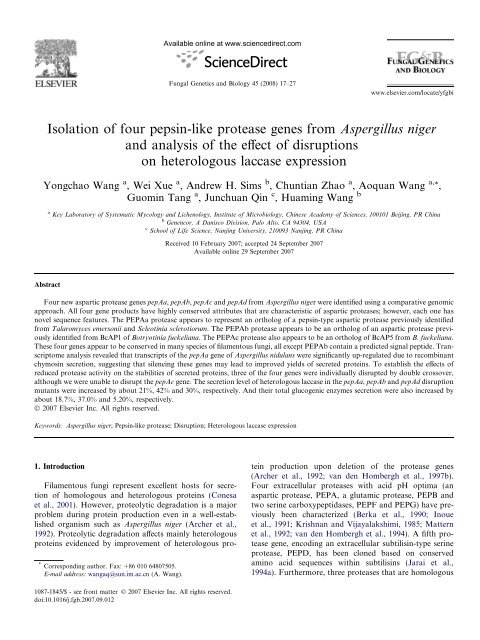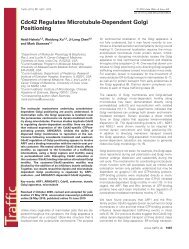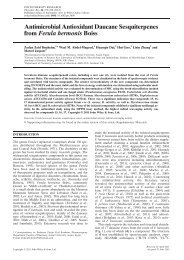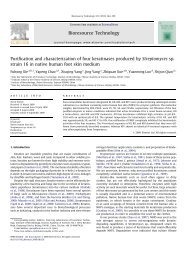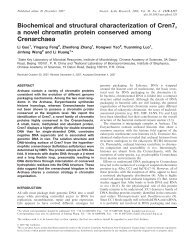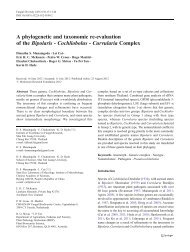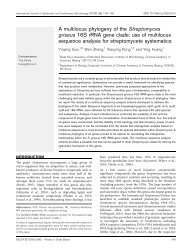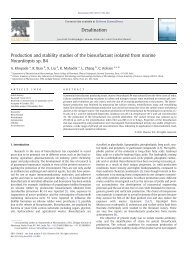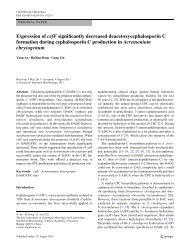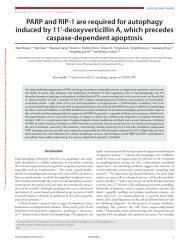Isolation of four pepsin-like protease genes from Aspergillus niger ...
Isolation of four pepsin-like protease genes from Aspergillus niger ...
Isolation of four pepsin-like protease genes from Aspergillus niger ...
You also want an ePaper? Increase the reach of your titles
YUMPU automatically turns print PDFs into web optimized ePapers that Google loves.
Available online at www.sciencedirect.com<br />
Fungal Genetics and Biology 45 (2008) 17–27<br />
www.elsevier.com/locate/yfgbi<br />
<strong>Isolation</strong> <strong>of</strong> <strong>four</strong> <strong>pepsin</strong>-<strong>like</strong> <strong>protease</strong> <strong>genes</strong> <strong>from</strong> <strong>Aspergillus</strong> <strong>niger</strong><br />
and analysis <strong>of</strong> the effect <strong>of</strong> disruptions<br />
on heterologous laccase expression<br />
Yongchao Wang a , Wei Xue a , Andrew H. Sims b , Chuntian Zhao a , Aoquan Wang a, *,<br />
Guomin Tang a , Junchuan Qin c , Huaming Wang b<br />
a Key Laboratory <strong>of</strong> Systematic Mycology and Lichenology, Institute <strong>of</strong> Microbiology, Chinese Academy <strong>of</strong> Sciences, 100101 Beijing, PR China<br />
b Genencor, A Danisco Division, Palo Alto, CA 94304, USA<br />
c School <strong>of</strong> Life Science, Nanjing University, 210093 Nanjing, PR China<br />
Received 10 February 2007; accepted 24 September 2007<br />
Available online 29 September 2007<br />
Abstract<br />
Four new aspartic <strong>protease</strong> <strong>genes</strong> pepAa, pepAb, pepAc and pepAd <strong>from</strong> <strong>Aspergillus</strong> <strong>niger</strong> were identified using a comparative genomic<br />
approach. All <strong>four</strong> gene products have highly conserved attributes that are characteristic <strong>of</strong> aspartic <strong>protease</strong>s; however, each one has<br />
novel sequence features. The PEPAa <strong>protease</strong> appears to represent an ortholog <strong>of</strong> a <strong>pepsin</strong>-type aspartic <strong>protease</strong> previously identified<br />
<strong>from</strong> Talaromyces emersonii and Scleotinia sclerotiorum. The PEPAb <strong>protease</strong> appears to be an ortholog <strong>of</strong> an aspartic <strong>protease</strong> previously<br />
identified <strong>from</strong> BcAP1 <strong>of</strong> Botryotinia fuckeliana. The PEPAc <strong>protease</strong> also appears to be an ortholog <strong>of</strong> BcAP5 <strong>from</strong> B. fuckeliana.<br />
These <strong>four</strong> <strong>genes</strong> appear to be conserved in many species <strong>of</strong> filamentous fungi, all except PEPAb contain a predicted signal peptide. Transcriptome<br />
analysis revealed that transcripts <strong>of</strong> the pepAa gene <strong>of</strong> <strong>Aspergillus</strong> nidulans were significantly up-regulated due to recombinant<br />
chymosin secretion, suggesting that silencing these <strong>genes</strong> may lead to improved yields <strong>of</strong> secreted proteins. To establish the effects <strong>of</strong><br />
reduced <strong>protease</strong> activity on the stabilities <strong>of</strong> secreted proteins, three <strong>of</strong> the <strong>four</strong> <strong>genes</strong> were individually disrupted by double crossover,<br />
although we were unable to disrupt the pepAc gene. The secretion level <strong>of</strong> heterologous laccase in the pepAa, pepAb and pepAd disruption<br />
mutants were increased by about 21%, 42% and 30%, respectively. And their total glucogenic enzymes secretion were also increased by<br />
about 18.7%, 37.0% and 5.20%, respectively.<br />
Ó 2007 Elsevier Inc. All rights reserved.<br />
Keywords: <strong>Aspergillus</strong> <strong>niger</strong>; Pepsin-<strong>like</strong> <strong>protease</strong>; Disruption; Heterologous laccase expression<br />
1. Introduction<br />
* Corresponding author. Fax: +86 010 64807505.<br />
E-mail address: wangaq@sun.im.ac.cn (A. Wang).<br />
Filamentous fungi represent excellent hosts for secretion<br />
<strong>of</strong> homologous and heterologous proteins (Conesa<br />
et al., 2001). However, proteolytic degradation is a major<br />
problem during protein production even in a well-established<br />
organism such as <strong>Aspergillus</strong> <strong>niger</strong> (Archer et al.,<br />
1992). Proteolytic degradation affects mainly heterologous<br />
proteins evidenced by improvement <strong>of</strong> heterologous protein<br />
production upon deletion <strong>of</strong> the <strong>protease</strong> <strong>genes</strong><br />
(Archer et al., 1992; van den Hombergh et al., 1997b).<br />
Four extracellular <strong>protease</strong>s with acid pH optima (an<br />
aspartic <strong>protease</strong>, PEPA, a glutamic <strong>protease</strong>, PEPB and<br />
two serine carboxypeptidases, PEPF and PEPG) have previously<br />
been characterized (Berka et al., 1990; Inoue<br />
et al., 1991; Krishnan and Vijayalakshimi, 1985; Mattern<br />
et al., 1992; van den Hombergh et al., 1994). A fifth <strong>protease</strong><br />
gene, encoding an extracellular subtilisin-type serine<br />
<strong>protease</strong>, PEPD, has been cloned based on conserved<br />
amino acid sequences within subtilisins (Jarai et al.,<br />
1994a). Furthermore, three <strong>protease</strong>s that are homologous<br />
1087-1845/$ - see front matter Ó 2007 Elsevier Inc. All rights reserved.<br />
doi:10.1016/j.fgb.2007.09.012
18 Y. Wang et al. / Fungal Genetics and Biology 45 (2008) 17–27<br />
to yeast vacuolar <strong>protease</strong>s have been cloned <strong>from</strong> A.<br />
<strong>niger</strong>; these are PEPE, a <strong>pepsin</strong>-type aspartyl endo<strong>protease</strong><br />
that is the homologue <strong>of</strong> the vacuolar pep4 gene<br />
product in yeast (Jarai et al., 1994b), PEPC, a subtilisintype<br />
serine endo<strong>protease</strong> (Frederick et al., 1993) and<br />
CPY, a serine carboxypeptidase (Yaver et al., 1995). Following<br />
the whole-genome sequencing <strong>of</strong> A. <strong>niger</strong> (Pel<br />
et al., 2007), approximately 200 predicted <strong>protease</strong>s have<br />
been identified, with similar numbers also seen following<br />
whole-genome sequencing <strong>of</strong> <strong>Aspergillus</strong> nidulans (Galagan<br />
et al., 2005), <strong>Aspergillus</strong> oryzae (Machida et al.,<br />
2005) and <strong>Aspergillus</strong> fumigatus (Nierman et al., 2005).<br />
Pepsin-<strong>like</strong> enzymes such as aspartic <strong>protease</strong>s are<br />
members <strong>of</strong> the A1 family <strong>of</strong> peptidases (Rawlings<br />
et al., 2004). This family comprises proteins with a<br />
three-dimensional structure close to that <strong>of</strong> <strong>pepsin</strong>. Generally,<br />
these enzymes form two domains with different<br />
amino acid sequences, but basically similar folds. The<br />
catalytic site <strong>of</strong> the <strong>pepsin</strong>-<strong>like</strong> enzymes is formed at<br />
the junction <strong>of</strong> the two domains. It contains two aspartic<br />
acid residues, Asp32 and Asp215 (human <strong>pepsin</strong> numbering),<br />
one in each domain (Blundell et al., 1998). In accordance<br />
with the accepted mechanism <strong>of</strong> the <strong>pepsin</strong>-<strong>like</strong><br />
enzyme function (James, 2004), the Asp215 has to be<br />
charged, whereas Asp32 has to be protonated. A remarkable<br />
property <strong>of</strong> the catalytic center is its adaptation for<br />
the action in a wide range <strong>of</strong> pH, <strong>from</strong> 4.0 to 7.0. Aspartic<br />
proteinases have been identified <strong>from</strong> Botrystis cinerea<br />
(ten Have et al., 2004) and A. oryzae (Machida et al.,<br />
2005).<br />
Berka et al. showed that deletion <strong>of</strong> the pepA gene<br />
increased bovine prochymosin production by more than<br />
66% (Berka et al., 1990). Van den Hombergh et al. disrupted<br />
three different acid-<strong>protease</strong> <strong>genes</strong> in A. <strong>niger</strong>,<br />
pepA, pepB and pepE, to determine the contribution <strong>of</strong><br />
each <strong>protease</strong> to the overall <strong>protease</strong> spectrum using<br />
bovine serum albumin as a broad substrate. They concluded<br />
that the PEPA and PEPB <strong>protease</strong>s appeared to<br />
constitute 84% and 6% <strong>of</strong> the extracellular acidic proteolytic<br />
activity, respectively, whereas the PEPE <strong>protease</strong> is<br />
responsible for 68% <strong>of</strong> the intracellular acidic <strong>protease</strong><br />
activity (van den Hombergh et al., 1997a). Moralejo<br />
et al. also showed that a defect in the pepA gene reduced<br />
degradation <strong>of</strong> overexpressed thaumatin in A. <strong>niger</strong><br />
(Moralejo et al., 2000).<br />
Here, we report the isolation and characterization <strong>of</strong><br />
<strong>four</strong> ‘new’ <strong>genes</strong> (pepAa, pepAb, pepAc and pepAd)<br />
encoding <strong>pepsin</strong>-<strong>like</strong> aspartic <strong>protease</strong>s <strong>from</strong> A. <strong>niger</strong><br />
and demonstrate that these <strong>genes</strong> are conserved within<br />
the <strong>Aspergillus</strong> genus. The proteins possess different characteristics<br />
and may have distinct localizations and functions.<br />
Transcription <strong>of</strong> the pepAa gene during<br />
recombinant protein production was observed with our<br />
A. nidulans cDNA microarray (Sims et al., 2005). Therefore,<br />
we examined the effect <strong>of</strong> disrupting these <strong>protease</strong>s<br />
on the secretion <strong>of</strong> the homologous and the heterologous<br />
proteins in A. <strong>niger</strong>.<br />
2. Materials and methods<br />
2.1. Strains and growth conditions<br />
A. <strong>niger</strong> GICC2773 (Valkonen et al., 2003) was used for<br />
the disruption experiments <strong>of</strong> the putative aspartic <strong>protease</strong><br />
<strong>genes</strong>. This strain contains the disruption mutant <strong>of</strong> the<br />
pepA gene and integrated heterologous gene (lcc1 <strong>of</strong><br />
theTrametes versicolor laccase gene) expressed as fusion<br />
to the glucoamylase. Escherichia coli DH5a served as host<br />
for routine DNA manipulations (Sambrook et al., 1989).<br />
<strong>Aspergillus</strong> <strong>niger</strong> GICC2773 strains were maintained on<br />
solid sporulation medium, GMP (2% glucose, 2% maltose<br />
extract, 0.1% peptone, 1% agar) supplemented with 0.3%<br />
casein when necessary. Disruption mutants were grown<br />
on GMP supplemented with 200 lg hygromycin B per<br />
ml. Seed cultures <strong>of</strong> the A. <strong>niger</strong> strains in 30 ml <strong>of</strong> S3Y2<br />
medium (3% soluble starch, 2% yeast extracts, 0.5%<br />
KH 2 PO 4 , 0.5% corn powder) were incubated at 30 °C with<br />
200 rpm agitation in a rotary G10 incubator (New Brunswick<br />
Scientific, NJ) for 14 h. For laccase production study,<br />
A. <strong>niger</strong> strains were grown in 30 ml <strong>of</strong> modified Promosoy<br />
medium (Ward et al., 2004), where the promosoy was<br />
substituted with tryptic soy broth (Difco, Detroit, MI).<br />
2.2. Protease identification and sequence analysis<br />
The predicted <strong>pepsin</strong>-<strong>like</strong> <strong>protease</strong>s were identified as<br />
described previously (Sims et al., 2004a,b). Briefly, files<br />
containing all the predicted open reading frames (ORFs)<br />
<strong>from</strong> species <strong>of</strong> filamentous fungi with recently completed<br />
whole-genome sequences (Table 2) were downloaded<br />
<strong>from</strong> their respective databases and filtered for sequences<br />
<strong>of</strong> 100 or more amino acids beginning with a methionine<br />
start codon. These were then searched for putative aspartic<br />
<strong>protease</strong> domains (PF00026) using the protein families<br />
and HMM database (Pfam) release 11.0 (Bateman et al.,<br />
2004). The results were compared to known <strong>protease</strong><br />
families in the peptidase database, MEROPS release 6.4<br />
(Rawlings et al., 2004). The coding sequences for predicted<br />
<strong>protease</strong>s were manually compared using the ClustalW<br />
program (Thompson et al., 1994) with default<br />
settings. Additional sequences <strong>of</strong> <strong>genes</strong> <strong>from</strong> other species<br />
that have previously been cloned and characterized<br />
were added to demonstrate that the ORFs represent<br />
putative orthologs <strong>of</strong> known <strong>genes</strong>. The Treeview program<br />
was used to draw and visualize hierarchical trees<br />
based upon amino acid sequence alignments (Page,<br />
1996). The SignalP (Nielsen et al., 1997) and ProP<br />
(Duckert et al., 2004) programs were used to identify<br />
prepro signal sequences and propeptide cleavage sites,<br />
respectively. The big-PI (http://mendel.imp.univie.ac.at/<br />
sat/gpi/fungi_server.html) fungal predictor was also used<br />
to identify <strong>like</strong>ly GPI modification sites (Eisenhaber<br />
et al., 2004). The disulfide bonds were predicted using<br />
DIpro 2.0 (http://contact.ics.uci.edu/bridge.html) (Cheng<br />
et al., 2006).
Y. Wang et al. / Fungal Genetics and Biology 45 (2008) 17–27 19<br />
2.3. Microarray analysis<br />
Transcriptome analysis was performed as described previously<br />
(Sims et al., 2005, 2004b,c). Briefly, a pyrG- singlecopy<br />
recombinant chymosin-producing A. nidulans strain<br />
(Cullen et al., 1987) was compared to its parental strain<br />
transformed with an empty vector. Shake flask cultures<br />
were grown on 500 ml <strong>of</strong> SCM media (Ward et al., 1990)<br />
in 2 l flasks. BLASTx was used to identify ESTs (expressed<br />
sequence tags) representing predicted cDNA (ORF)<br />
sequences <strong>from</strong> the A. nidulans genome sequence<br />
(www.broad.mit.edu). Differential gene expression was calculated<br />
after normalisation in MaxDView (www.bioinf.man.ac.uk/microarray/)<br />
and significance values<br />
determined as described previously (Sims et al., 2004c).<br />
2.4. Plasmid construction<br />
For construction <strong>of</strong> gene disruption plasmid, the <strong>four</strong><br />
pepAx <strong>genes</strong> (x represents a, b, c, or d) were amplified <strong>from</strong><br />
genomic DNA <strong>of</strong> A. <strong>niger</strong> using primers P Ax1 and P Ax2<br />
listed in Table 1, which were designed according to the<br />
sequence <strong>of</strong> the pepAx <strong>genes</strong> <strong>of</strong> A. <strong>niger</strong>. At the 5 0 end <strong>of</strong><br />
each primer, a restriction enzyme recognition site <strong>of</strong> HpaI<br />
was introduced. The PCR was carried out with Pfu DNA<br />
polymerase and consisted <strong>of</strong> one cycle at 94 °C for 4 min<br />
and 30 cycles at 94 °C for 1 min, 55 °C for 1 min, 72 °C<br />
for 2.5 min, and then a final extension at 72 °C for<br />
10 min. Following the PCR, amplified DNA was cloned<br />
into a pBluescript KS(+) vector to yield the plasmid<br />
pBS-TMx. A 1.5 kb BamHI/SalI fragment <strong>from</strong> pMW1,<br />
containing the PpcbC-hph expression cassette, was filled<br />
in with Klenow fragment and then inserted into the<br />
intended disruption site <strong>of</strong> pBS-TMx to construct the final<br />
disruption plasmid pAxS-T.<br />
2.5. Transformation <strong>of</strong> A. <strong>niger</strong><br />
Protoplasts <strong>of</strong> A. <strong>niger</strong> strains were prepared with reference<br />
to Campbell et al. (1989) and transformed by the polyethylene<br />
glycol method (Yelton et al., 1984). For the<br />
disruption <strong>of</strong> the pepAx <strong>genes</strong> in A. <strong>niger</strong> (strain<br />
GICC2773), the plasmid pAxS-T was digested with HpaI.<br />
The resulting DNA disruption fragment and the 3.0 kb<br />
Table 1<br />
List <strong>of</strong> primers used in the disruption experiments a<br />
5 0 Primer 3 0 Primer<br />
P Aa1 5 0 -GCACTTCTTTCCCCTTTTTGTTTAC-3 0 P Aa2 5 0 -AGGTTAACTTGAATTGTAGATACAGCCAC-3 0<br />
P Ab1 5 0 -ACGTTAACCATATCACAGCTATATCCCC-3 0 P Ab2 5 0 -ACGTTAACGCCAGGTCCTCCTTCTGC-3 0<br />
P Ac1 5 0 -TGGTTAACGAGGGATTGCTCTATTG-3 0 P Ac2 5 0 -TGGTTAACTGTGCTATGCTATTGGTG-3 0<br />
P Ad1 5 0 -TGGTTAACTCGTAAGTAGGTAGGCTG-3 0 P Ad2 5 0 -ATGTTAACCCGAGGTGCTGCTTG-3 0<br />
P hph 5 0 -GAGGGCAAAGGAATAGAGTAGATG-3 0<br />
P outAa n.d. P outAa 5 0 -TCATGGATTAGGGTTAGAAAGAGTG-3 0<br />
P outAb 5 0 -GGAGAGATAGGACGTAAACTTCATG-3 0 P outAb n.d.<br />
P outAc n.d. P outAc 5 0 -TCATGTGAATATGTGCACGAAGGTG-3 0<br />
P outAd n.d. P outAd 5 0 -AGAGCAGAGAAGAAATACTGAGGAG-3 0<br />
P Aa3 5 0 -TCCTCCAGTCCCTCATTGTTGCC-3 0 P Aa4 5 0 -AACTCGTACTCGCCCACTCCGTC-3 0<br />
P Ab3 Same as P Ab1 P Ab4 Same as P Ab2<br />
P Ac3 Same as P Ac1 P Ac4 5 0 -TCTGCTCGTCGGTGGTTGTG-3 0<br />
P Ad3 Same as P Ad1 P Ad4 Same as P Ad2<br />
a The introduced restriction sites <strong>of</strong> HpaI are indicated in bold.<br />
Table 2<br />
Predicted aspartic <strong>protease</strong>s in the species <strong>of</strong> filamentous ascomycetes<br />
Species<br />
No. predicted<br />
ORFs<br />
Sequenced by<br />
Website<br />
<strong>Aspergillus</strong> fumigatus 7 Consortium (Nierman et al., 2005) http://www.cadre.man.ac.uk/<br />
8 NRRL 3—Integrated genomics/genencor http://www.jgi.doe.gov/<br />
<strong>Aspergillus</strong> <strong>niger</strong> 8 ATCC 1015—Joint Genome Institute http://www.jgi.doe.gov/<br />
8 CBS 513.88—DSM (Pel et al., 2007) http://www.jgi.doe.gov/<br />
Aspegillus oryzae 12 National Institute <strong>of</strong> Technology and Evaluation (Machida<br />
et al., 2005)<br />
http://www.bio.nite.go.jp/ngac/e/rib40-<br />
e.html<br />
<strong>Aspergillus</strong> nidulans 9 Broad Institute (Galagan et al., 2005) http://www.broad.mit.edu/<br />
Magnaporthe grisea 16 Broad Institute http://www.broad.mit.edu/<br />
Neurospora crassa 16 Broad Institute http://www.broad.mit.edu/<br />
Fusarium<br />
15 Broad Institute http://www.broad.mit.edu/<br />
graninearum<br />
Trichoderma reesei 16 Joint Genome Institute http://www.jgi.doe.gov/<br />
Open-reading frames were found to contain the Pfam domain PF00026, suggesting that they are members <strong>of</strong> the peptidase A1 family (<strong>pepsin</strong> family).
20 Y. Wang et al. / Fungal Genetics and Biology 45 (2008) 17–27<br />
vector fragment were used to transform the A. <strong>niger</strong> strain<br />
GICC2773. Hygromycin B resistant transformants were<br />
selected in GMP with 0.8 M sucrose as osmotic stabilizer<br />
supplemented with 200 lg/ml hygromycin B.<br />
2.6. DNA isolation<br />
Genomic DNA <strong>of</strong> the A. <strong>niger</strong> strains was obtained by a<br />
modification <strong>of</strong> the benzyl chloride extraction method (Zhu<br />
et al., 1993) as follows: the fungi were grown in S3Y2 medium<br />
for 16 h at 30 °C and harvested by filtration on Nytal<br />
30 filters. To each sample, 500 ll extraction buffer (100 mM<br />
Tris–HCl, pH 9.0, 40 mM EDTA), 100 ll 10% SDS and<br />
300 ll benzyl chloride were added. The tube was vortexed<br />
and incubated in 50 °C for 1 h with shaking or repeatedly<br />
vortexing at 10 min interval to keep the two phases thoroughly<br />
mixed. Then 300 ll 3 M NaOAc, pH 5.0, was added<br />
to the tube and kept on ice for 15 min. After centrifugation<br />
at 12,000 rpm, 4 °C for 10 min, the supernatant was collected,<br />
and DNA was precipitated with isopropanol.<br />
0.1 M HOAc buffer at pH 4.6) as substrate and incubated<br />
at 37 °C for 30 min. The reaction was stopped by boiling.<br />
The glucose liberated was quantified by the glucose oxidase/peroxidase<br />
method using a glucose assay kit<br />
(Zhongsheng Biotechnology and Science Inc. product).<br />
The optical density at 525 nm was measured and the<br />
amount <strong>of</strong> glucose produced was calculated. The expression<br />
level <strong>of</strong> total glucogenic enzymes was indicated in<br />
the units <strong>of</strong> total enzymes activity secreted per gram dry<br />
2.7. PCR screening <strong>of</strong> transformants for homologous<br />
recombination<br />
The organization <strong>of</strong> the targeted gene and its neighbouring<br />
regions were examined by PCR for the disruption <strong>of</strong><br />
pepAx <strong>genes</strong> using oligonucleotide primer pairs as follows:<br />
(i) primers annealing to the hph gene and the sequence outside<br />
homologous fragment: P hph and P outAx (see Table 1);<br />
(ii) primers annealed outside the disrupted site <strong>of</strong> pepAx<br />
<strong>genes</strong>: P Ax3 and P Ax4 (see Table 1). PCR consisted <strong>of</strong> one<br />
cycle at 94 °C for 4 min and 30 cycles at 94 °C for 1 min,<br />
55 °C for 1 min, 72 °C for 2.5 min, and then a final extension<br />
at 72 °C for 10 min.<br />
2.8. Laccase expression assay<br />
<strong>Aspergillus</strong> <strong>niger</strong> strains GICC2773, DpepAa, DpepAb<br />
and DpepAd were grown in modified Promosoy medium<br />
at 28 °C and 200 rpm for 144 h. Culture filtrate and mycelium<br />
were collected by centrifugation. For laccase assay a<br />
30 ll amount <strong>of</strong> appropriately diluted sample solution<br />
was mixed with 2.9 ml 0.1 M HOAc buffer (pH 4.6) and<br />
70 ll 20 mM ABTS substrate and incubated at 37 °C for<br />
30 min. The optical density at 420 nm was measured. One<br />
unit <strong>of</strong> laccase activity is defined as the amount <strong>of</strong> enzyme<br />
oxidizing 1 lmol <strong>of</strong> ABTS per min. For determination <strong>of</strong><br />
mycelium dry weight the collected mycelium was washed,<br />
squeezed, blotted dry and dried at 80 °C for 3 h before<br />
weighing. The expression level <strong>of</strong> laccase was indicated in<br />
the laccase activity (international units) produced per gram<br />
dry weight <strong>of</strong> mycelium ( IU/g ).<br />
2.9. Assay <strong>of</strong> total glucogenic enzymes activity<br />
A60ll amount <strong>of</strong> culture filtrate collected above was<br />
mixed with 140 ll H 2 O and 2.8 ml 2% soluble starch (in<br />
Fig. 1. Hierarchical clustering <strong>of</strong> sequence alignments <strong>of</strong> the ORFs<br />
predicted to represent <strong>genes</strong> <strong>of</strong> the A1 aspartic <strong>protease</strong> family (<strong>pepsin</strong><br />
family) in the <strong>Aspergillus</strong> genus. Clustering performed using the ClustalW<br />
(Thompson et al., 1994) program with default settings. The tree was drawn<br />
with Treeview program (Page, 1996) and is rooted with human <strong>pepsin</strong> A<br />
sequence. Previously isolated fungal aspartic <strong>protease</strong>s in the MEROPS<br />
database (Rawlings et al., 2004) are in bold. GenBank Accession numbers<br />
are presented in brackets, <strong>Aspergillus</strong> hypothetical proteins are defined by<br />
locus ID accession numbers, for details <strong>of</strong> genome sequences (see Table 2).
Y. Wang et al. / Fungal Genetics and Biology 45 (2008) 17–27 21<br />
weight <strong>of</strong> mycelium (U/g). One unit <strong>of</strong> glucogenic enzyme<br />
activity was defined as the amount <strong>of</strong> enzymes that liberated<br />
1 lmol glucose per min <strong>from</strong> soluble starch.<br />
3. Results<br />
3.1. Identification and characterization <strong>of</strong> <strong>four</strong> <strong>pepsin</strong>-<strong>like</strong><br />
<strong>protease</strong>s<br />
In a survey <strong>of</strong> all the predicted <strong>protease</strong>s encoded by 22<br />
species <strong>of</strong> fungi that have recently undergone whole-genome<br />
sequencing (Sims et al., 2004a), a number <strong>of</strong> putative<br />
novel <strong>pepsin</strong>-<strong>like</strong> aspartic <strong>protease</strong>s were identified. Within<br />
the filamentous ascomycetes, between 7 and 16 open-reading<br />
frames for each species were predicted to represent<br />
aspartic <strong>protease</strong>s based upon their conserved sequence<br />
to the Pfam domain PF00026 (Bateman et al., 2004) for<br />
members <strong>of</strong> the peptidase A1 (<strong>pepsin</strong>) family <strong>of</strong> <strong>protease</strong>s<br />
(Table 2). The Eurotiales class (including three species <strong>of</strong><br />
<strong>Aspergillus</strong>) contained approximately half as many predicted<br />
aspartic <strong>protease</strong>s as the Pezizales and Sordariales<br />
classes (including Magnaporthe grisea, Neurospora crassa,<br />
Fig. 2. Alignment <strong>of</strong> the predicted amino acid sequences <strong>of</strong> the <strong>four</strong> A. <strong>niger</strong> aspartic <strong>protease</strong>s (PEPAa–PEPAd) with that <strong>of</strong> aspergillo<strong>pepsin</strong> A (PEPA) using<br />
ClustalW (Thompson et al., 1994). Signal peptides for all sequences (except PEPAb) are boldfaced. The possible KexB cleavage sites found in pepAa (RR),<br />
pepAc (KR) and pepAd (KR) were marked with an arrow. Hallmark motifs in aspartic <strong>protease</strong>s are indicated by black shading blocks. The active site motifs<br />
were shown in italics. A serine-rich region at the C-terminus was boxed. The predicted GPI-modification site was double underlined. Locations <strong>of</strong> the cysteine<br />
residues for the predicted disulfide bonds are shown with grey shading blocks. The insertion sites for PEPAa, PEPAb and PEPAd were shown in ‘‘.’’.
22 Y. Wang et al. / Fungal Genetics and Biology 45 (2008) 17–27<br />
Fig. 3. The A. nidulans putative ortholog (AN2517.1) <strong>of</strong> the A. <strong>niger</strong><br />
pepAa <strong>pepsin</strong>-<strong>like</strong> <strong>protease</strong> is significantly differentially expressed during<br />
increasing heterologous chymosin secretion. Expression in chymosinproducing<br />
strain is relative to the parental strain. Error bars are equal to<br />
one standard deviation <strong>of</strong> the mean (three repeats) and the values above<br />
and below the dotted lines were previously shown to represent significant<br />
changes in gene expression (Sims et al., 2005).<br />
Fusarium graninearum and Trichoderma reesei). Eight predicted<br />
ORFs <strong>from</strong> the NRRL3 strain <strong>of</strong> A. <strong>niger</strong> sequenced<br />
by Genencor/Integrated were found to contain the Pfam<br />
domain PF00026 for members <strong>of</strong> the peptidase A1 (<strong>pepsin</strong>).<br />
All eight ORFs with 100% amino acid sequence<br />
matches were found in the ‘best protein models’ download<br />
<strong>of</strong> the whole-genome sequencing <strong>of</strong> the ATCC 1015 strain<br />
<strong>of</strong> A. <strong>niger</strong> by the Joint Genome Institute. Eight predicted<br />
<strong>genes</strong> were also identified to contain this Pfam domain in<br />
the whole-genome sequencing <strong>of</strong> the CBS 513.88 strain <strong>of</strong><br />
A. <strong>niger</strong> by DSM (Pel et al., 2007). Four <strong>of</strong> these <strong>genes</strong><br />
(referred to <strong>from</strong> here on as pepAa, pepAb, pepAc and<br />
pepAd) encode <strong>pepsin</strong>-<strong>like</strong> <strong>protease</strong>s. Putative orthologs<br />
for all <strong>four</strong> <strong>genes</strong> were also identified in A. nidulans, A. oryzae<br />
and A. fumigatus, suggesting that these <strong>genes</strong> are well<br />
conserved within the <strong>Aspergillus</strong> genus (Fig. 1). However,<br />
the sequence <strong>of</strong> A. nidulans AN6686.1 appears to be distinctly<br />
different <strong>from</strong> the putative A. <strong>niger</strong> and A. fumigatus<br />
pepAb orthologs. It may be due to incorrect gene designation<br />
which has been a problem with the A. nidulans wholegenome<br />
sequence (Sims et al., 2005). Comparison <strong>of</strong> the<br />
predicted aspartic <strong>protease</strong> sequences listed in the peptidase<br />
database (MEROPS) using ClustalW (Thompson et al.,<br />
1994) demonstrated that the predicted pepAx sequences<br />
were <strong>like</strong>ly to be orthologs <strong>of</strong> previously isolated <strong>genes</strong><br />
<strong>from</strong> different species <strong>of</strong> filamentous fungi. The first,<br />
denoted PEPAa <strong>protease</strong> seems to represent an ortholog<br />
<strong>of</strong> the <strong>pepsin</strong>-type aspartic <strong>protease</strong> previously identified<br />
<strong>from</strong> Talaromyces emersonii (AF439995, unpublished)<br />
and Scleotinia sclerotiorum (Poussereau et al., 2001). Further<br />
conserved sequence, PEPAb and PEPAc appear to<br />
be orthologs <strong>of</strong> aspartic <strong>protease</strong>s (BcAP1 and BcAP5) previously<br />
identified <strong>from</strong> Botryotinia fuckeliana (ten Have<br />
et al., 2004). The closest known ortholog to PEPAd is<br />
aspartyl <strong>protease</strong> 4 <strong>from</strong> Coccidioides posadasii<br />
(ABA54909, unpublished). The pepAa orthologs have an<br />
extra A. oryzae one, as previously demonstrated for the<br />
pepA and pepE ‘clusters’ (Machida et al., 2005).<br />
The pepAx <strong>genes</strong> encode proteins <strong>of</strong> 394, 426, 453 and<br />
480 amino acids, respectively, which are in agreement with<br />
other aspartic proteinases <strong>of</strong> fungal origin. PEPAa, PEPAc<br />
and PEPAd appear to contain a signal peptide (boldfaced<br />
in Fig. 2). Possible KexB cleavage sites (Arginine and<br />
Lysine) were detected in PEPAa, PEPAc and PEPAd (see<br />
Fig. 2). Alignment <strong>of</strong> the predicted amino acid sequences<br />
<strong>of</strong> the <strong>four</strong> A. <strong>niger</strong> proteins (PEPAx) with the previously<br />
isolated aspartic <strong>protease</strong>, aspergillo<strong>pepsin</strong> A (PEPA) demonstrates<br />
that functional regions <strong>of</strong> these proteins are<br />
highly conserved (Fig. 2), such as the active site motif<br />
Asp101-Thr102-Gly103 <strong>of</strong> aspergillo<strong>pepsin</strong> A numbering<br />
in Fig. 2 (James, 2004). Asp residue (Asp156 in aspergillo<strong>pepsin</strong><br />
A) was not conserved since the PEPAc (see<br />
Fig. 2) has a Glu residue at this position as seen in other<br />
aspartic <strong>protease</strong> (Capasso et al., 1998). PEPAd has a long<br />
C-terminal extension consisting <strong>of</strong> about 70 residues. This<br />
extension contains lengthy stretches <strong>of</strong> hydrophilic, predominantly<br />
serine residues, terminating with roughly 20<br />
hydrophobic residues, which may facilitate extracellular<br />
attachment. An algorithm for identifying fungal glycosylphosphatidylinositol<br />
(GPI) modification motifs (Eisenhaber<br />
et al., 2004) predicted that GPI modification in PEPAd<br />
occurs at Gly456 with high probability scores <strong>of</strong> S >15<br />
(see Fig. 2). A disulfide bond predictor (DIpro 2.0) (Cheng<br />
et al., 2006) suggested that PEPAa had one disulfide bond<br />
between residues 382–389, in the same region as one predicted<br />
for PEPA. In addition to conserved predicted disulfide<br />
bonds in this region (between residues 365–402 and<br />
339–370, respectively), PEPAc and PEPAd were also predicted<br />
to have an N-terminal disulfide bond (between residues<br />
130–144 and 137–142, respectively), however, PEPAb<br />
was predicted to have none (see Fig. 2).<br />
3.2. Microarray results<br />
One <strong>of</strong> the unknown transcripts found to be significantly<br />
up-regulated during recombinant chymosin secretion (25–<br />
50 h) in A. nidulans shake flask cultures (Sims et al.,<br />
2005) was putatively identified by sequence similarity to<br />
represent a <strong>pepsin</strong>-<strong>like</strong> peptidase (Fig. 3). BLASTx was<br />
used to establish that this transcript represents the hypothetical<br />
ORF AN2157.1, which appears to encode the A.<br />
nidulans ortholog <strong>of</strong> the PEPAa <strong>protease</strong> (Fig. 1).<br />
3.3. Disruption <strong>of</strong> pepAa, pepAb, pepAc and pepAd <strong>genes</strong><br />
We disrupted pepAa, pepAb and pepAd <strong>genes</strong> by homologous<br />
recombination. Fig. 4a shows disruption strategies<br />
for construction <strong>of</strong> the disruption plasmids and for identification<br />
<strong>of</strong> disruption strains. In all three cases, the corresponding<br />
<strong>genes</strong> were amplified by PCR (data not shown)<br />
and the hygromycin resistant gene was inserted into the
Y. Wang et al. / Fungal Genetics and Biology 45 (2008) 17–27 23<br />
gene at a restriction site so the hygromycin resistant gene respectively (Section 2). Screening <strong>of</strong> fungal transformants<br />
was flanked by homologous AB fragment at the 5 0 end by PCR using the primer pair <strong>of</strong> P hph and P outAx (Table 1)<br />
and homologous BC fragment at the 3 0 end (Fig. 4a). identified transformant #23 as a disruption strain for the<br />
<strong>Aspergillus</strong>. <strong>niger</strong> GICC2773 protoplasts were transformed pepAa gene (Fig. 4b), transformant #17 as a disruption<br />
with HpaI fragment <strong>of</strong> pAaS-T, pAbS-T and pAdS-T, strain for the pepAb gene (Fig. 4c) and transformant #29<br />
Fig. 4. (a) Disruption strategy for the pepAx (pepAa, pepAb, pepAc and pepAd) gene <strong>of</strong> A. <strong>niger</strong>. The expected pattern <strong>of</strong> PCR products is indicated for the<br />
parental strain (fragment I) and for the disruption mutants (fragment II) using the indicated primer pairs <strong>of</strong> P Ax3 and P Ax4 . No PCR product is expected<br />
for the parental strain. Fragment III is expected for the disruption mutants using the indicated primer pairs <strong>of</strong> P hph and P outAb . Fragment IV is expected<br />
for the disruption mutants using the indicated primer pairs <strong>of</strong> P hph and P outAa ,P outAc and P outAd . (b) PCR analysis and identification <strong>of</strong> the pepAa<br />
disruption strain. From left to right, lane 1 is the DNA molecule weight marker, lanes 2 and 3 used template DNA <strong>from</strong> the parental strain (GICC2773),<br />
lanes 4 and 5 used template <strong>from</strong> a transformant with ectopic integration (AN#6), and lanes 6 and 7 are the disruption mutant (A. NDpepAa #23). The<br />
PCR primers used for lanes 2, 4 and 6 are P Aa3 and P Aa4 . The PCR primers used for lanes 3, 5 and 7 are P hph and P outAa. (c) PCR analysis and<br />
identification <strong>of</strong> the pepAb disruption strain. From left to right, lane 1 is the DNA molecule weight marker, lanes 2 and 3 used template DNA <strong>from</strong> the<br />
parental strain (GICC2773), lanes 4 and 5 used template <strong>from</strong> a transformant with ectopic integration (AN#1), and lanes 6 and 7 are the disruption mutant<br />
(A.NDpepAb#17). The PCR primers used for lanes 2, 4 and 6 are P Ab3 and P Ab4 . The PCR primers used for lanes 3, 5 and 7 are P hph and P outAb. (d) PCR<br />
analysis and identification <strong>of</strong> the pepAd disruption strain. From left to right, lane 1 is the DNA molecule weight marker, lanes 2 and 3 used template DNA<br />
<strong>from</strong> the parental strain (GICC2773), lanes 4 and 5 used template <strong>from</strong> a transformant with ectopic integration (AN#8), and lanes 6 and 7 are the<br />
disruption mutant (A.NDpepAa#29). The PCR primers used for lanes 2, 4 and 6 are P Ad3 and P Ad4 . The PCR primers used for lanes 3, 5 and 7 are P hph and<br />
P outAd.
24 Y. Wang et al. / Fungal Genetics and Biology 45 (2008) 17–27<br />
as a disruption strain for the pepAd gene (Fig. 4d). The specific<br />
bands (1.14 kb PCR product <strong>from</strong> the pepAa disruption<br />
strain, 1.19 kb PCR product <strong>from</strong> the pepAb<br />
disruption strain and 1.08 kb PCR product <strong>from</strong> the pepAd<br />
disruption strain) resulted <strong>from</strong> homologous recombination<br />
were detected only in the disruption strains, not in<br />
the wild type strain (GICC2773) or the epitopic integration<br />
strain (AN#6 <strong>of</strong> Fig. 4b, AN#1 <strong>of</strong> Fig. 4c and AN#8 <strong>of</strong><br />
Fig. 4d). The specific PCR fragments were also sequenced<br />
to confirm their identity (data not shown). In addition,<br />
using primer pair <strong>of</strong> P Ax3 and P Ax4 (Table 1), the amplified<br />
PCR fragments showed differences <strong>of</strong> 1.5 kb when comparing<br />
the disruption strains to the wild type strain or the epitopic<br />
integration strain. In the pepAa disruption strain a<br />
2.32 kb PCR fragment was detected compared to a<br />
0.82 kb fragment in the wild type strain (Fig. 4b). Similarly,<br />
the pepAb disruption strain had a 3.67 kb rather than a<br />
2.17 kb PCR fragment (Fig. 4c) and the pepAd disruption<br />
strain had a 3.66 kb rather than the 2.16 kb PCR fragment<br />
in wild type strain (Fig. 4d). In an attempt to disrupt the<br />
pepAc gene in A. <strong>niger</strong> GICC2773 strain, we generated<br />
286 transformants in <strong>four</strong> experiments and screened all<br />
transformants by PCR with primers P hph and P outAc . However,<br />
no transformant could be identified containing the<br />
pepAc disruption pattern <strong>of</strong> a 1520 bp specific band resulting<br />
<strong>from</strong> homologous recombination.<br />
3.4. Effect <strong>of</strong> gene disruptions on laccase production<br />
We tested laccase expression <strong>of</strong> all disruption strains by<br />
growing them in shake flasks for 144 h in modified Promosoy<br />
medium and then assaying the laccase activity in the<br />
supernatants. We observed a 42% average increase <strong>of</strong> the<br />
laccase production in the strain A.NDpepAb#17 with<br />
respect to the parental strain GICC2773 in two parallel<br />
experiments. Analysis <strong>of</strong> secretion level <strong>of</strong> the laccase also<br />
revealed that a 21% average increase <strong>of</strong> the laccase expression<br />
in the strain A.NDpepAa#23 and a 30% average<br />
increase in the strain A.NDpepAd#29 (Table 3).<br />
3.5. Effect <strong>of</strong> gene disruptions on production <strong>of</strong> native protein<br />
The secretion <strong>of</strong> total glucogenic enzymes in culture filtrate<br />
was analyzed in the three disruption mutants. The<br />
strain A.NDpepAa#23 and A.NDpepAb#17 showed significant<br />
increase in the expression level <strong>of</strong> their glucogenic<br />
enzymes by approximately 19% and 37%, respectively.<br />
However, there was a only slight increase (5.2%) in the<br />
strain containing the disruption <strong>of</strong> the pepAd gene (Table 3).<br />
4. Discussion<br />
Four <strong>pepsin</strong>-<strong>like</strong> <strong>protease</strong> <strong>genes</strong> were identified and<br />
characterized <strong>from</strong> A. <strong>niger</strong>, the products <strong>of</strong> which have<br />
characteristics that are novel among aspartic <strong>protease</strong>s<br />
<strong>from</strong> filamentous ascomycetes. Sequence analysis demonstrated<br />
that these <strong>genes</strong> appear to be highly conserved<br />
within the <strong>Aspergillus</strong> genus. Both the sequence alignment/clustering<br />
program, ClustalW and Pfam/MEROPS<br />
classification system are dependent upon the level <strong>of</strong><br />
sequence similarity. Therefore, the clusters that are generated<br />
correspond to discrete members <strong>of</strong> the same MER-<br />
OPS and Pfam families. At the most conserved level,<br />
within individual protein families, clustering by sequence<br />
similarity can identify orthologs and paralogs (Sims<br />
et al., 2004a). Whole-genome sequencing <strong>of</strong> closely related<br />
species has resulted in the identification <strong>of</strong> predicted <strong>protease</strong>s<br />
that represent orthologs <strong>of</strong> previously isolated <strong>genes</strong><br />
<strong>from</strong> different species. Using this approach, it is also possible<br />
to identify orthologs which have not been isolated previously<br />
and may also lead to the re-classification <strong>of</strong> some<br />
<strong>protease</strong>s. For example, A. <strong>niger</strong> PEPA is denoted<br />
A01.016 in MEROPS peptidase database (Rawlings et al.,<br />
2004) and yet it is sandwiched between A01.026 peptidase<br />
F <strong>from</strong> A. oryzae and A. fumigatus (see Fig. 1).<br />
The <strong>Aspergillus</strong> PEPAd sequences appear to have a conserved<br />
C-terminal modification that may facilitate their<br />
association with the cell membrane by means <strong>of</strong> GPI<br />
anchor (Hamada et al., 1998). The Saccharomyces cerevisiae<br />
aspartic <strong>protease</strong>s yapsin 1, 2 and 3 have all been shown<br />
to be GPI-anchored proteins (Ash et al., 1995; Cawley<br />
et al., 1995) and B. cinerea BcAP3 and 4 contains similar<br />
domain (ten Have et al., 2004). Moreover, PEPAd contains<br />
serine-rich stretches just upstream <strong>of</strong> the GPI modification<br />
site (Fig. 2). These stretches might be targets for O-glycosylation,<br />
which may facilitate adherence to the extracellular<br />
glucan matrix <strong>of</strong> A. <strong>niger</strong>. An aspartic <strong>protease</strong> that is<br />
attached to the cell membrane by a GPI anchor, or embedded<br />
in the hyphal matrix, might support various functions<br />
such as the maturation <strong>of</strong> other fungal hydrolytic enzymes,<br />
the proteolysis <strong>of</strong> host cell wall protein in the vicinity <strong>of</strong> the<br />
hyphal tip.<br />
Perhaps the most distinctive features <strong>of</strong> these <strong>four</strong><br />
A. <strong>niger</strong> sequences are those <strong>of</strong> PEPAb. While it does contain<br />
all the residues necessary to function as an active proteolytic<br />
enzyme, the sequence <strong>of</strong> PEPAb is highly atypical; it<br />
is not predicted to contain any disulfide bonds. In particular,<br />
the C-terminal disulfide bond conserved in virtually all<br />
other eukaryotic aspartic <strong>protease</strong> sequences is absent, the<br />
precursors are commonly synthesized on membrane-bound<br />
ribosomes and the nascent polypeptide chains are directed<br />
into the endoplasmic reticulum where the disulfide bonds<br />
are introduced by post-translational modification to<br />
enhance stability. Predicted orthologs <strong>of</strong> PEPAb <strong>from</strong> a<br />
number <strong>of</strong> filamentous fungal species were also predicted<br />
to lack disulfide bonds and a conventional signal peptide.<br />
These enzymes have sequences with very acidic isoelectric<br />
points; the predicted pI value for the putative N. crassa<br />
ortholog <strong>of</strong> PEPAb is almost as acidic as that <strong>of</strong> pig <strong>pepsin</strong><br />
which operates in a very acidic environment (pH < 2) in the<br />
stomach. Thus, whatever the mechanism <strong>of</strong> trafficking <strong>of</strong><br />
these proteins, the cellular compartment in which they<br />
finally reside can be predicted to be very acidic, otherwise<br />
each polypeptide would unfold and denature. Although a
Y. Wang et al. / Fungal Genetics and Biology 45 (2008) 17–27 25<br />
signal peptide sequence could not be identified for PEPAb,<br />
the absence <strong>of</strong> a ‘typical’ signal peptide sequence in a<br />
secreted protein is not unprecedented. The superoxide dismutase<br />
BcSOD1 in B. cinerea also lacks a signal peptide<br />
sequence but was unequivocally demonstrated to be a<br />
secreted protein (Rolke et al., 2004).<br />
Real-time quantitative RT-PCR was performed to<br />
establish whether the pepAx <strong>genes</strong> are stimulated by heterologous<br />
protein production. All <strong>four</strong> aspartic <strong>protease</strong><br />
<strong>genes</strong> were transcribed in the laccase expressing strain<br />
(Fig. 5), although there was no significant difference in<br />
the level <strong>of</strong> gene expression compared with parental strain<br />
(data not shown), suggesting that transcription <strong>of</strong> the <strong>protease</strong>s<br />
does not directly respond to the expression <strong>of</strong> heterologous<br />
laccase. Perhaps these proteins are constitutively<br />
expressed under given certain culture conditions or only<br />
induced by certain heterologous proteins. The expression<br />
<strong>of</strong> a transcript representing the A. nidulans ortholog <strong>of</strong> pep-<br />
Aa was observed to up-regulated in a chymosin-producing<br />
strain compared to its parent (Fig. 3).<br />
Fig. 5. Detection <strong>of</strong> pepAx transcripts by RT-PCR. 215, 100, 236 and<br />
176 bp amplified products were detected for pepAa, pepAb, pepAc and<br />
pepAd <strong>genes</strong>, respectively. RNA was extracted <strong>from</strong> GICC2773 strain.<br />
The effect <strong>of</strong> silencing pepAa, pepAb and pepAd expression<br />
on homologous and heterologous protein secretion<br />
in A. <strong>niger</strong> was analyzed. The laccase activities were<br />
increased by 21%, 42% and 30%, respectively, in the pepAa,<br />
pepAb and pepAd gene disruption strains. The effect <strong>of</strong> the<br />
pepAb gene disruption, despite the lack <strong>of</strong> a signal peptide<br />
and disulfide bonds, suggesting the PEPAb is <strong>like</strong>ly to be<br />
another important <strong>protease</strong> leading to low production <strong>of</strong><br />
heterologous proteins, though the substrate specificity <strong>of</strong><br />
different <strong>protease</strong>s should be considered. The increased<br />
production <strong>of</strong> laccase by disruption <strong>of</strong> the pepAd gene, is<br />
relatively small compared with that obtained <strong>from</strong> pepAb<br />
removal, which could support the hypothesis deduced <strong>from</strong><br />
the sequence characterization that PEPAd is <strong>like</strong>ly to be a<br />
GPI-anchored <strong>protease</strong>. The proteolytic effect <strong>of</strong> GPIanchored<br />
or membrane-embedded <strong>protease</strong> may be limited,<br />
and may only degrade heterologous proteins in the vicinity<br />
<strong>of</strong> the cell wall as compared to extracellular <strong>protease</strong>s.<br />
The effect <strong>of</strong> disruptions <strong>of</strong> these three <strong>protease</strong>s on<br />
homologous proteins production was also studied. In comparison<br />
with the parental strain, there was no significant<br />
change in glucogenic enzymes production in the pepAd disruption<br />
mutant which could represent a protective mechanism<br />
to prevent native proteins <strong>from</strong> degradation by<br />
nascent <strong>protease</strong>s (Calmels et al., 1991). However, in the<br />
<strong>pepsin</strong>s and the majority <strong>of</strong> other members <strong>of</strong> the family<br />
show specificity for the cleavage <strong>of</strong> bonds in peptides <strong>of</strong><br />
at least six residues with hydrophobic amino acids in both<br />
the Pl and Pl 0 positions. So the proteolytic activity <strong>of</strong> the<br />
same <strong>protease</strong> to different heterologous proteins will vary<br />
and the relative degradation ability compared with other<br />
aspartic <strong>protease</strong>s needs to be examined with a number<br />
<strong>of</strong> different substrates due to the substrate specificities for<br />
enzymes.<br />
To disrupt the pepAc gene in A. <strong>niger</strong>, a total <strong>of</strong> 286<br />
transformants were generated in <strong>four</strong> experiments. All<br />
transformants were screened by PCR, but none was identified<br />
to contain the pepAc gene knockout. It is not known<br />
why no disruptant was obtained, However, a number <strong>of</strong><br />
<strong>pepsin</strong>ogen <strong>genes</strong> are reported to be located in the centromeric<br />
region <strong>of</strong> human chromosome 11 (Taggart et al.,<br />
1985), where homologous recombination in such area in<br />
A. <strong>niger</strong> is so infrequent.<br />
Table 3<br />
Extracellular laccase and glucogenic enzyme activity secreted by <strong>protease</strong>-deficient and wild type strains<br />
Strain<br />
Mycelium dry<br />
weight a,c (g/L)<br />
Laccase<br />
Activity a,b,c<br />
(IU/L)<br />
Activity relative to<br />
mycelium dry weight<br />
(IU/g)<br />
Activity relative to<br />
parental strain (%)<br />
Glucogenic enzymes<br />
Activity a,b,c<br />
(U/L)<br />
Activity relative to<br />
mycelium dry<br />
weight (U/g)<br />
DpepAa#23 8.48 ± 0.36 479 ± 20.7 56.5 ± 1.22 121.0 7.96 ± 0.20 954.0 ± 70.2 118.7<br />
DpepAb#17 8.37 ± 0.40 555 ± 31.0 66.3 ± 3.01 142.0 8.07 ± 0.28 119.2 ± 77.6 137.0<br />
DpepAd#29 8.12 ± 0.30 491 ± 17.8 60.7 ± 1.76 130.0 6.98 ± 0.23 842.0 ± 66.9 105.2<br />
GICC2773 10.22 ± 0.78 476 ± 10.7 46.7 ± 2.72 100 7.74 ± 0.13 800.6 ± 15.2 100<br />
a Data are averages ± standard deviation <strong>of</strong> eight determinations (<strong>four</strong> replicates for two independent experiments).<br />
b The supernatant was used as crude enzyme for the enzyme activity assay.<br />
c The cultivation was carried out for 144 h. For all cultures the final pH was approximately 4.6.<br />
Activity relative to<br />
parental strain (%)
26 Y. Wang et al. / Fungal Genetics and Biology 45 (2008) 17–27<br />
Residual proteolytic activity (other than that accredited<br />
to identified <strong>protease</strong>s) remains a big challenge for the production<br />
<strong>of</strong> heterologous protein such as laccase (Archer<br />
et al., 1992; Conesa et al., 2001). The roles <strong>of</strong> these <strong>protease</strong>s<br />
and their contribution to laccase degradation are<br />
unclear at this time. Some <strong>of</strong> them might have intracellular<br />
proteolytic activities required for adequate protein processing<br />
and thus might be indispensable. On the other hand, we<br />
do not know the substrate specificity for each <strong>of</strong> these <strong>protease</strong>s,<br />
especially for the laccase molecule. Knowing the<br />
specificities <strong>of</strong> the <strong>protease</strong>s will undoubtedly broaden<br />
our methods to improve strains for heterologous protein<br />
production by selectively disrupting one or more <strong>genes</strong>.<br />
In summary, removal <strong>of</strong> proteolytic degradation due to<br />
the presence <strong>of</strong> PEPAx is a useful method for increasing<br />
laccase production in A. <strong>niger</strong>. This strategy, in association<br />
with the removal <strong>of</strong> aspergillo<strong>pepsin</strong> A (van den Hombergh<br />
et al., 1997a) and other aspartic <strong>protease</strong>s by combining<br />
multiple gene disruptions, by classical muta<strong>genes</strong>is and<br />
by physiological optimization <strong>of</strong> culture medium, represents<br />
a good method to result in large increases in heterologous<br />
protein production in A. <strong>niger</strong>. In future, it would be<br />
interesting to look at the effects <strong>of</strong> disrupting multiple pep-<br />
Ax <strong>genes</strong> or generating strains that silence all <strong>protease</strong>s that<br />
are known to affect yields <strong>of</strong> recombinant proteins.<br />
Acknowledgments<br />
This work was supported by grants <strong>from</strong> Genencor, a<br />
Danisco Division, Palo Alto, California, USA. Authors<br />
would <strong>like</strong> to thank Michael Ward for his critical reading.<br />
References<br />
Archer, D.B., MacKenzie, D.A., Jeenes, D.J., Roberts, I.N., 1992.<br />
Proteolytic degradation <strong>of</strong> heterologous proteins expressed in <strong>Aspergillus</strong><br />
<strong>niger</strong>. Biotechnol. Lett. 14, 357–362.<br />
Ash, J., Dominguez, M., Bergeron, J.J., Thomas, D.Y., Bourbonnais, Y.,<br />
1995. The yeast proprotein convertase encoded by yap3 is a<br />
glycophosphatidylinositol-anchored protein that localizes to the<br />
plasma membrane. J. Biol. Chem. 270, 20847–20854.<br />
Bateman, A., Coin, L., Durbin, R., Finn, R.D., Hollich, V., Griffiths-<br />
Jones, S., Khanna, A., Marshall, M., Moxon, S., Sonnhammer, E.L.,<br />
Studholme, D.J., Yeats, C., Eddy, S.R., 2004. The Pfam protein<br />
families database. Nucleic Acids Res. 32, D138–D141.<br />
Berka, R.M., Ward, M., Wilson, L.J., Hayenga, K.J., Kodama, K.H.,<br />
Carlomagno, L.P., Thompson, S.A., 1990. Molecular cloning and<br />
deletion <strong>of</strong> the gene encoding aspergillo<strong>pepsin</strong> A <strong>from</strong> A. awamori.<br />
Gene 86, 153–162.<br />
Blundell, T.L., Guruprassas, K., Albert, A., Williams, M., Sibanda, B.L.,<br />
Dhanarai, V., 1998. The aspartic proteinases. an historical overview.<br />
Adv. Exp. Med. Biol. 436, 1–13.<br />
Calmels, T.P.G., Martin, F., Durand, H., Tiraby, G., 1991. Proteolytic<br />
events in the processing <strong>of</strong> secreted proteins in fungi. J. Biotechnol. 17,<br />
51–66.<br />
Campbell, E.I., Unkles, S.E., Macro, J.A., van den Hondel, C., Contreras,<br />
R., Kinghorn, J.R., 1989. Improved transformation efficiency <strong>of</strong><br />
<strong>Aspergillus</strong> <strong>niger</strong> using the homologous niaD gene for nitrate reductase.<br />
Curr. Genet. 16, 53–56.<br />
Capasso, C., Riggo, M., Scudiero, R., Carginale, V., di Prisco, G., Kay, J.,<br />
Kille, P., Parisi, E., 1998. Molecular cloning and sequence determination<br />
<strong>of</strong> a novel aspartic proteinase <strong>from</strong> Antarctic fish. Biochim.<br />
Biophys. Acta 1387, 457–461.<br />
Cawley, N.X., Wong, M., Pu, L.P., Tam, W., Loh, Y.P., 1995. Secretion<br />
<strong>of</strong> yeast aspartic <strong>protease</strong> 3 is regulated by its carboxy-terminal tail:<br />
characterization <strong>of</strong> secreted YAP3p. Biochemistry 34, 7430–7437.<br />
Cheng, J., Saigo, H., Baldi, P., 2006. Large-scale prediction <strong>of</strong> disulphide<br />
bridges using kernel methods, two-dimensional recursive neural<br />
networks, and weighted graph matching. Proteins 62 (3), 617–629.<br />
Conesa, A., Punt, P.J., van Luijk, M., van den Hondel, C.A., 2001. The<br />
secretion pathway in filamentous fungi: a biotechnological view.<br />
Fungal Genet. Biol. 33, 155–171.<br />
Cullen, D., Gray, G.L., Wilson, L.J., Hayenga, K.J., Lamsa, M.H., Rey,<br />
M.W., Norton, S., Berka, R.A., 1987. Controlled expression and<br />
secretion <strong>of</strong> bovine chymosin in <strong>Aspergillus</strong> nidulans. Biotechnology 5,<br />
369–376.<br />
Duckert, P., Brunak, S., Blom, N., 2004. Prediction <strong>of</strong> proprotein<br />
convertase cleavage sites. Protein Eng. Des. Sel. 17, 107–112.<br />
Eisenhaber, B., Schneider, G., Wildpaner, M., Eisenhaber, F., 2004. A<br />
sensitive predictor for potential GPI lipid modification sites in fungal<br />
protein sequences and its application to genome-wide studies for<br />
<strong>Aspergillus</strong> nidulans, Candida albicans, Neurospora crassa, Saccharomyces<br />
cerevisiae, and Schizosaccharomyces pombe. J. Mol. Biol. 337,<br />
243–253.<br />
Frederick, G.D., Rombouts, P., Buxton, F.P., 1993. Cloning and<br />
characterisation <strong>of</strong> pepC, a gene encoding a serine <strong>protease</strong> <strong>from</strong><br />
<strong>Aspergillus</strong> <strong>niger</strong>. Gene 125, 57–64.<br />
Galagan, J.E., Calvo, S.E., Cuomo, C., Ma, L.J., Wortman, J.R.,<br />
Batzoglou, S., Lee, S.I., Basturkmen, M., Spevak, C.C., Clutterbuck,<br />
J., Kapitonov, V., Jurka, J., Scazzocchio, C., Farman, M., Butler, J.,<br />
Purcell, S., Harris, S., Braus, G.H., Draht, O., Busch, S., D’Enfert, C.,<br />
Bouchier, C., Goldman, G.H., Bell-Pedersen, D., Griffiths-Jones, S.,<br />
Doonan, J.H., Yu, J., Vienken, K., Pain, A., Freitag, M., Selker, E.U.,<br />
Archer, D.B., Penalva, M.A., Oakley, B.R., Momany, M., Tanaka, T.,<br />
Kumagai, T., Asai, K., Machida, M., Nierman, W.C., Denning, D.W.,<br />
Caddick, M., Hynes, M., Paoletti, M., Fischer, R., Miller, B., Dyer, P.,<br />
Sachs, M.S., Osmani, S.A., Birren, B.W., 2005. Sequencing <strong>of</strong><br />
<strong>Aspergillus</strong> nidulans and comparative analysis with A. fumigatus and<br />
A. oryzae. Nature 438 (7071), 1105–1115.<br />
Hamada, K., Fukuchi, S., Arisawa, M., Baba, M., Kitada, K., 1998.<br />
Screening for glycosylphosphatidylinositol (GPI)-dependent cell wall<br />
proteins in Saccharomyces cerevisiae. Mol. Gen. Genet. 258, 53–59.<br />
Inoue, H., Kimura, T., Makabe, O., Takahashi, K., 1991. The gene and<br />
deduced protein sequences <strong>of</strong> the zymogen <strong>of</strong> <strong>Aspergillus</strong> <strong>niger</strong> acid<br />
proteinase A. J. Biol. Chem. 266, 19484–19489.<br />
James, M.N.G., 2004. Catalytic pathway <strong>of</strong> aspartic peptidases. In:<br />
Barrett, A.J., Rawlings, N.D., Woessner, J.F. (Eds.), Handbook <strong>of</strong><br />
Proteolytic Enzymes. Elsevier, London, pp. 12–19.<br />
Jarai, G., Kirchherr, D., Buxton, F.P., 1994a. Cloning and characterization<br />
<strong>of</strong> the pepD gene <strong>of</strong> <strong>Aspergillus</strong> <strong>niger</strong> which codes for a subtilisin<strong>like</strong><br />
<strong>protease</strong>. Gene 139, 51–57.<br />
Jarai, G., Van Den Hombergh, J.P.T.W., Buxton, F.P., 1994b. Cloning and<br />
characterization <strong>of</strong> the pepE gene <strong>of</strong> <strong>Aspergillus</strong> <strong>niger</strong> encoding a new<br />
aspartic <strong>protease</strong> and regulation <strong>of</strong> pepE and pepC. Gene 145, 171–178.<br />
Krishnan, S., Vijayalakshimi, M.A., 1985. Purification <strong>of</strong> an acid <strong>protease</strong><br />
and a serine carboxypeptidase <strong>from</strong> <strong>Aspergillus</strong> <strong>niger</strong> using metalchelate<br />
affinity chromatography. J. Chromatogr. 329, 165–170.<br />
Machida, M., Asai, K., Sano, M., Tanaka, T., Kumagai, T., Terai, G.,<br />
Kusumoto, K., Arima, T., Akita, O., Kashiwagi, Y., Abe, K., Gomi, K.,<br />
Horiuchi, H., Kitamoto, K., Kobayashi,T.,Takeuchi,M.,Denning,D.W.,<br />
Galagan, J.E., Nierman, W.C., Yu, J., Archer, D.B., Bennett, J.W.,<br />
Bhatnagar, D., Cleveland, T.E., Fedorova, N.D., Gotoh, O., Horikawa,<br />
H., Hosoyama, A., Ichinomiya, M., Igarashi, R., Iwashita, K., Juvvadi,<br />
P.R., Kato, M., Kato, Y., Kin, T., Kokubun, A., Maeda, H., Maeyama, N.,<br />
Maruyama, J., Nagasaki, H., Nakajima, T., Oda, K., Okada, K., Paulsen,<br />
I., Sakamoto, K., Sawano, T., Takahashi, M., Takase, K., Terabayashi, Y.,<br />
Wortman, J.R., Yamada, O., Yamagata, Y., Anazawa, H., Hata, Y.,<br />
Koide,Y.,Komori,T.,Koyama,Y.,Minetoki, T., Suharnan, S., Tanaka,<br />
A., Isono, K., Kuhara, S., Ogasawara, N., Kikuchi, H., 2005. Genome
Y. Wang et al. / Fungal Genetics and Biology 45 (2008) 17–27 27<br />
sequencing and analysis <strong>of</strong> <strong>Aspergillus</strong> oryzae. Nature 438 (7071),<br />
1157–1161.<br />
Mattern, I.E., van Noort, J.M., van den, B.P., Archer, D.B., Roberts,<br />
I.N., van den Hondel, C.A., 1992. <strong>Isolation</strong> and characterization <strong>of</strong><br />
mutants <strong>of</strong> <strong>Aspergillus</strong> <strong>niger</strong> deficient in extracellular <strong>protease</strong>s. Mol.<br />
Gen. Genet. 234, 332–336.<br />
Moralejo, F.J., Cardoza, R.E., Gutierrez, S., Sisniega, H., Faus, I.,<br />
Martín, J.F., 2000. Overexpression and lack <strong>of</strong> degradation <strong>of</strong><br />
thaumatin in an aspergillo<strong>pepsin</strong> A-defective mutant <strong>of</strong> <strong>Aspergillus</strong><br />
awamori containing an insertion in the pepA gene. Appl. Microbiol.<br />
Biotechnol. 54, 772–777.<br />
Nielsen, H., Engelbrecht, J., Brunak, S., Heijne, G., 1997. Identification <strong>of</strong><br />
prokaryotic and eukaryotic signal peptides and prediction <strong>of</strong> their<br />
cleavage sites. Protein Eng. 10, 1–6.<br />
Nierman, W.C., Pain, A., Anderson, M.J., Wortman, J.R., Kim, H.S.,<br />
Arroyo, J., Berriman, M., Abe, K., Archer, D.B., Bermejo, C.,<br />
Bennett, J., Bowyer, P., Chen, D., Collins, M., Coulsen, R., Davies, R.,<br />
Dyer, P.S., Farman, M., Fedorova, N., Fedorova, N., Feldblyum,<br />
T.V., Fischer, R., Fosker, N., Fraser, A., Garcia, J.L., Garcia, M.J.,<br />
Goble, A., Goldman, G.H., Gomi, K., Griffith-Jones, S., Gwilliam, R.,<br />
Haas, B., Haas, H., Harris, D., Horiuchi, H., Huang, J., Humphray,<br />
S., Jimenez, J., Keller, N., Khouri, H., Kitamoto, K., Kobayashi, T.,<br />
Konzack, S., Kulkarni, R., Kumagai, T., Lafon, A., Latge, J.P., Li,<br />
W., Lord, A., Lu, C., Majoros, W.H., May, G.S., Miller, B.L.,<br />
Mohamoud, Y., Molina, M., Monod, M., Mouyna, I., Mulligan, S.,<br />
Murphy, L., O’Neil, S., Paulsen, I., Penalva, M.A., Pertea, M., Price,<br />
C., Pritchard, B.L., Quail, M.A., Rabbinowitsch, E., Rawlins, N.,<br />
Rajandream, M.A., Reichard, U., Renauld, H., Robson, G.D.,<br />
Rodriguez de Cordoba, S., Rodriguez-Pena, J.M., Ronning, C.M.,<br />
Rutter, S., Salzberg, S.L., Sanchez, M., Sanchez-Ferrero, J.C.,<br />
Saunders, D., Seeger, K., Squares, R., Squares, S., Takeuchi, M.,<br />
Tekaia, F., Turner, G., Vazquez de Aldana, C.R., Weidman, J., White,<br />
O., Woodward, J., Yu, J.H., Fraser, C., Galagan, J.E., Asai, K.,<br />
Machida, M., Hall, N., Barrell, B., Denning, D.W., 2005. Genomic<br />
sequence <strong>of</strong> the pathogenic and allergenic filamentous fungus <strong>Aspergillus</strong><br />
fumigatus. Nature 438 (7071), 1151–1156.<br />
Page, R.D.M., 1996. TREEVIEW: an application to display phylogenetic<br />
trees on personal computers. Comput. Appl. Biosci. 12, 357–358.<br />
Pel, H.J., de Winde, J.H., Archer, D.B., Dyer, P.S., H<strong>of</strong>mann, G., Schaap,<br />
P.J., Turner, G., de Vries, R.P., Albang, R., Albermann, K., Andersen,<br />
M.R., Bendtsen, J.D., Benen, J.A., van den Berg, M., Breestraat, S.,<br />
Caddick, M.X., Contrera, R., Cornell, M., Coutinho, P.M., Danchin,<br />
E.G., Debets, A.J., Dekker, P., van Dijck, P.W., van Dijk, A.,<br />
Dijkhuizen, L., Driessen, A.J., d’Enfert, C., Geysens, S., Goosen, C.,<br />
Groot, G.S., de Groot, P.W., Guillemette, T., Henrissat, B., Herweijer,<br />
M., van den Hombergh, J.P., van den Hondel, C.A., van der Heijden,<br />
R.T., van der Kaaij, R.M., Klis, F.M., Kools, H.J., Kubicek, C.P., van<br />
Kuyk, P.A., Lauber, J., Lu, X., van der Maarel, M.J., Meulenberg, R.,<br />
Menke, H., Mortimer, M.A., Nielsen, J., Oliver, S.G., Olsthoorn, M.,<br />
Pal, K., van Peij, N.N., Ram, A.F., Rinas, U., Roubos, J.A., Sagt,<br />
C.M., Schmoll, M., Sun, J., Ussery, D., Varga, J., Vervecken, W., van<br />
de Vondervoort, P.J., Wedler, H., Wosten, H.A., Zeng, A.P., van<br />
Ooyen, A.J., Visser, J., Stam, H., 2007. Genome sequencing and<br />
analysis <strong>of</strong> the versatile cell factory <strong>Aspergillus</strong> <strong>niger</strong> CBS 513.88. Nat.<br />
Biotechnol. 25 (2), 221–231.<br />
Poussereau, N., Gente, S., Rascle, C., Bilon-Grand, G., Fevre, M., 2001.<br />
aspS encoding an unusual aspartyl <strong>protease</strong> <strong>from</strong> Sclerotinia sclerotiorum<br />
is expressed during phytopatho<strong>genes</strong>is. FEMS Microbiol. Lett.<br />
194, 27–32.<br />
Rawlings, N.D., Tolle, D.P., Barrett, A.J., 2004. MEROPS: the peptidase<br />
database. Nucleic Acids Res. 32, 160–164.<br />
Rolke, Y., Liu, S., Quidde, T., Williamson, B., Schouten, A., Weltring,<br />
K.-M., Siewers, V., Tudzynski, B., Tudzynski, P., 2004. Functional<br />
analysis <strong>of</strong> H 2 O 2 -generating systems in Botrytis cinerea: the major<br />
Cu-Zn-superoxide dismutase (BcSOD1) contributes to virulence on<br />
French bean, whereas a glucose oxidase (BcGOD1) is dispensable.<br />
Mol. Plant Pathol. 5, 17–28.<br />
Sambrook, J., Fritsch, E.F., Maniatis, T., 1989. Molecular Cloning: A<br />
Laboratory Manual. Cold Spring Harbor Laboratory Press, New<br />
York.<br />
Sims, A.H., Dunn-Coleman, N.S., Robson, G.D., Oliver, S.G., 2004a.<br />
Glutamic <strong>protease</strong> distribution is limited to filamentous fungi. FEMS<br />
Microbiol. Lett. 239, 95–101.<br />
Sims, A.H., Gent, M.E., Lanthaler, K., Dunn-Coleman, N.S., Oliver,<br />
S.G., Robson, G.D., 2005. Transcriptome analysis <strong>of</strong> recombinant<br />
protein secretion by <strong>Aspergillus</strong> nidulans and the unfolded protein<br />
response in vivo. Appl. Environ. Microbiol. 71, 2737–2747.<br />
Sims, A.H., Gent, M.E., Robson, G.D., Dunn-Coleman, N.S., Oliver,<br />
S.G., 2004b. Combining transcriptome data with genomic and cDNA<br />
sequence alignments to make confident functional assignments for<br />
<strong>Aspergillus</strong> nidulans <strong>genes</strong>. Mycol. Res. 108, 853–857.<br />
Sims, A.H., Robson, G.D., Hoyle, D.C., Oliver, S.G., Turner, G., Prade,<br />
R.A., Russell, H.H., Dunn-Coleman, N.S., Gent, M.E., 2004c. Use <strong>of</strong><br />
expressed sequence tag analysis and cDNA microarrays <strong>of</strong> the<br />
filamentous fungus <strong>Aspergillus</strong> nidulans. Fungal Genet. Biol. 41, 199–<br />
212.<br />
Taggart, R.T., Mohandast, T.K., Showst, T.B., Bell, G.I., 1985. Variable<br />
numbers <strong>of</strong> <strong>pepsin</strong>ogen <strong>genes</strong> are located in the centromeric region <strong>of</strong><br />
human chromosome 11 and determine the high-frequency electrophoretic<br />
polymorphism. Proc. Natl. Acad. Sci. USA 82, 6240–6244.<br />
ten Have, A., Dekkers, E., Kay, J., Phylip, L.H., van Kan, J.A., 2004. An<br />
aspartic proteinase gene family in the filamentous fungus Botrytis<br />
cinerea contains members with novel features. Microbiology 150,<br />
2475–2489.<br />
Thompson, J.D., Higgins, D.G., Gibson, T.J., 1994. CLUSTALW:<br />
improving the sensitivity <strong>of</strong> progressive multiple sequence alignment<br />
through sequence weighting, position-specific gap penalties and weight<br />
matrix choice. Nucleic Acids Res. 11, 4673–4680.<br />
Valkonen, M., Ward, M., Wang, H., Penttila, M., Saloheimo, M., 2003.<br />
Improvement <strong>of</strong> foreign-protein production in <strong>Aspergillus</strong> <strong>niger</strong> var.<br />
awamori by constitutive induction <strong>of</strong> the unfolded-protein response.<br />
Appl. Environ. Microbiol. 69 (12), 6979–6986.<br />
van den Hombergh, J.P.T.W., Jarai, G., Buxton, F.P., Visser, J., 1994.<br />
Cloning, characterization and expression <strong>of</strong> pepF, a gene encoding a<br />
serine carboxypeptidase <strong>from</strong> <strong>Aspergillus</strong> <strong>niger</strong>. Gene 151, 73–79.<br />
van den Hombergh, J.P.T.W., Sollewijn Gelpke, M.D., van de Vondervoort,<br />
P.J.I., Buxton, F.P., Visser, J., 1997a. Disruption <strong>of</strong> three acid<br />
<strong>protease</strong>s in <strong>Aspergillus</strong> <strong>niger</strong>—effects on <strong>protease</strong> spectrum, intracellular<br />
proteolysis, and degradation <strong>of</strong> target proteins. Eur. J. Biochem.<br />
247, 605–613.<br />
van den Hombergh, J.P.T.W., van de Vondervoort, P.J.I., Fraissinet-<br />
Tachet, L., Visser, J., 1997b. <strong>Aspergillus</strong> as a host for heterologous<br />
protein production: the problem <strong>of</strong> <strong>protease</strong>s. Trends Biotechnol. 15,<br />
256–263.<br />
Ward, M., Wilson, L.J., Kodama, K.H., Rey, M.H., Berka, R.M., 1990.<br />
Improved production <strong>of</strong> chymosin in <strong>Aspergillus</strong> by expression as a<br />
glucoamylase-chymosin fusion. Biotechnology (NY) 8, 435–440.<br />
Ward, M., Lin, C., Victoria, D., Fox, B., Fox, J., Wong, D., Meerman, H.,<br />
Pucci, J., Heng, M., Tsurushita, N., Gieswein, C., Park, M., Wang, H.,<br />
2004. Characterization <strong>of</strong> humanized antibodies secreted by <strong>Aspergillus</strong><br />
<strong>niger</strong>. Appl. Environ. Microbiol. 70, 2567–2576.<br />
Yaver, D.S., Thompson, S.A., Golightly, E.J., Nelson, B., 1995.<br />
Proceeding <strong>of</strong> the 18th Fungal Genetics Conference. Pacific Grove,<br />
CA, p. 62.<br />
Yelton, M.M., Hamer, J.E., Timberlake, W.E., 1984. Transformation <strong>of</strong><br />
<strong>Aspergillus</strong> nidulans by using a trpC plasmid. Proc. Natl. Acad. Sci.<br />
USA 81, 1470–1474.<br />
Zhu, H., Qu, F., Zhu, L.H., 1993. <strong>Isolation</strong> <strong>of</strong> genomic DNAs <strong>from</strong><br />
plants, fungi and bacteria using benzyl chloride. Nucleic Acids Res. 21,<br />
5279–5280.


